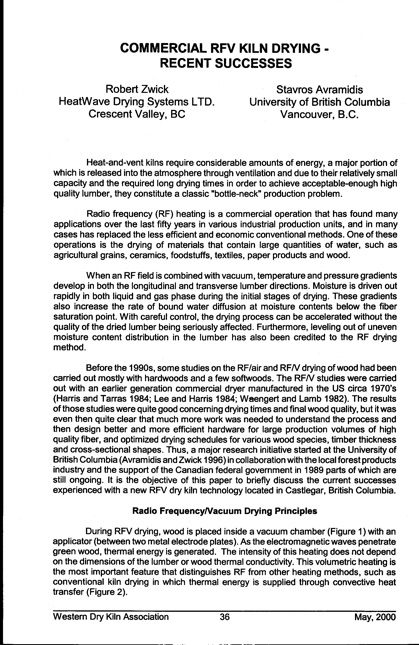
PDF Publication Title:
Text from PDF Page: 001
COMMERCIAL RFV KILN DRYING - RECENT SUCCESSES Robert Zwick� HeatWave Drying Systems LTD.� Crescent Valley, BC� Stavros Avramidis University of British Columbia Vancouver, B.C. Heat-and-vent kilns require considerable amounts of energy, a major portion of which is released into the atmosphere through ventilation and due to their relatively small capacity and the required long drying times in order to achieve acceptable-enough high quality lumber, they constitute a classic "bottle-neck" production problem. Radio frequency (RF) heating is a commercial operation that has found many applications over the last fifty years in various industrial production units, and in many cases has replaced the less efficient and economic conventional methods. One of these operations is the drying of materials that contain large quantities of water, such as agricultural grains, ceramics, foodstuffs, textiles, paper products and wood. When an RF field is combined with vacuum, temperature and pressure gradients develop in both the longitudinal and transverse lumber directions. Moisture is driven out rapidly in both liquid and gas phase during the initial stages of drying. These gradients also increase the rate of bound water diffusion at moisture contents below the fiber saturation point. With careful control, the drying process can be accelerated without the quality of the dried lumber being seriously affected. Furthermore, leveling out of uneven moisture content distribution in the lumber has also been credited to the RF drying method. Before the 1990s, some studies on the RF/air and RF/V drying of wood had been carried out mostly with hardwoods and a few softwoods. The RFN studies were carried out with an earlier generation commercial dryer manufactured in the US circa 1970's (Harris and Tarras 1984; Lee and Harris 1984; Waengert and Lamb 1982). The results of those studies were quite good concerning drying times and final wood quality, but it was even then quite clear that much more work was needed to understand the process and then design better and more efficient hardware for large production volumes of high quality fiber, and optimized drying schedules for various wood species, timber thickness and cross-sectional shapes. Thus, a major research initiative started at the University of British Columbia (Avramidis and Zwick 1996) in collaboration with the local forest products industry and the support of the Canadian federal government in 1989 parts of which are still ongoing. It is the objective of this paper to briefly discuss the current successes experienced with a new RFV dry kiln technology located in Castlegar, British Columbia. Radio FrequencyNacuum Drying Principles During RFV drying, wood is placed inside a vacuum chamber (Figure 1) with an applicator (between two metal electrode plates). As the electromagnetic waves penetrate green wood, thermal energy is generated. The intensity of this heating does not depend on the dimensions of the lumber or wood thermal conductivity. This volumetric heating is the most important feature that distinguishes RF from other heating methods, such as conventional kiln drying in which thermal energy is supplied through convective heat transfer (Figure 2). Western Dry Kiln Association� 36� May, 2000PDF Image | COMMERCIAL RFV KILN DRYING

PDF Search Title:
COMMERCIAL RFV KILN DRYINGOriginal File Name Searched:
Commercial_RFV_ocr.pdfDIY PDF Search: Google It | Yahoo | Bing
5,000 BF Shipping Container Lumber Dry Kiln For Quality Lumber The 5,000 BF container kiln consists of one 40 foot high-cube aluminum shipping container... More Info
Shipping Container Lumber Dry Kilns by Global Energy Global Energy designed and developed the container kiln back in 1991. The purpose is to give access to portable sawmill owners, furniture makers, and small business the value added profit of dry kiln lumber and quality hardwoods... More Info
Vacuum Kiln Conversion Kit for Lumber and Wood Dry Kilns Convert your existing conventional dry kiln into a fast drying vacuum kiln. Similar to vacuum bagging in the boat building and aircraft industry, we have come up with a proprietary process which allows you to build a very simple vacuum kiln at a fraction of the price, and without the intensive conventional metal chamber structure... More Info
Vacuum Pump Cart System for Bagging Clamping Wood Drying and more Vacuum Cart with 2HP Pump and Dual Pistons with multiple multiplex vacuum ports and liquid reservoir... More Info
Vacuum Bagging Basics Vacuum bagging is a method of clamping, which has traditionally been used in the composites industry, but can also be used for vacuum drying materials, including wood products... More Info
| CONTACT TEL: 608-238-6001 Email: greg@globalmicroturbine.com | RSS | AMP |